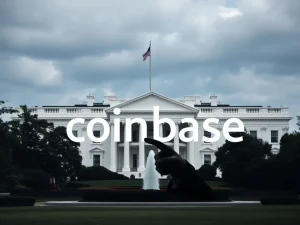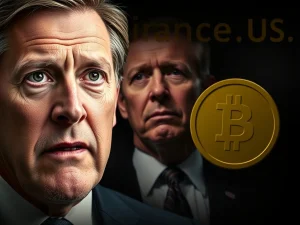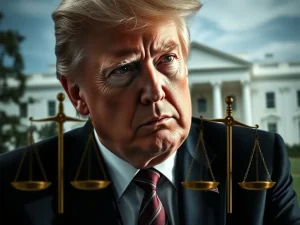CFTC SEC Unleashing a New Era: US Crypto Policy Takes Center Stage

The world of digital assets is constantly evolving, and with it, the landscape of regulation. A significant development is currently underway as the Commodity Futures Trading Commission (CFTC) and the Securities and Exchange Commission (SEC) embark on a joint “crypto sprint.” This initiative aims to translate the ambitious White House crypto recommendations into tangible policy, potentially ushering in a new era of clarity and growth for the US digital asset markets. For anyone deeply invested in the future of finance, understanding this collaborative effort is crucial.
CFTC SEC Collaboration: A United Front for Digital Assets
The announcement from Acting CFTC Chair Caroline Pham signaled a proactive stance, stating the agency would “work closely” with SEC Chair Paul Atkins and Commissioner Hester Peirce on its “Project Crypto” initiative. This joint effort underscores a critical shift towards a more unified regulatory approach, a welcome sign for many in the industry who have long called for coordinated oversight rather than fragmented jurisdiction. The stated goal is ambitious: to fulfill President Trump’s vision of making America the “crypto capital of the world.” This commitment from two of the most powerful financial regulators to collaborate on digital asset regulation suggests a concerted push to establish a robust framework. The “crypto sprint” is a direct response to recommendations put forth by the President’s Working Group on Digital Asset Markets, a report born from President Trump’s comprehensive crypto-related executive order earlier in the year. This top-down directive ensures that the agencies are not just reacting to market developments but are actively shaping the regulatory environment in line with national policy objectives.
Shaping US Crypto Policy: White House Directives
The President’s Working Group report provided a detailed roadmap, issuing 18 specific recommendations that involved the CFTC. While many recommendations required inter-agency cooperation, two were directly addressed to the CFTC, highlighting its pivotal role in the burgeoning digital asset space.
- Clarifying Commodity Status and DeFi: The first direct request urged the CFTC to advance initiatives providing guidance on how various cryptocurrencies could be classified as commodities. This is a crucial distinction, as it dictates which regulatory body has primary oversight. Furthermore, the report called for clarity on how the CFTC’s existing registration requirements would apply to decentralized finance (DeFi) protocols, a rapidly growing sector that challenges traditional regulatory models. Guidance for CFTC-regulated entities on permissible activities involving crypto was also emphasized, aiming to provide a clearer operational framework.
- Adapting Rules for Blockchain Derivatives: The second standalone task for the CFTC involved considering amendments to existing rules to accommodate blockchain-based derivatives. This acknowledges the innovation within the derivatives market and the need for regulatory frameworks to evolve alongside technological advancements.
Beyond these direct mandates, 16 other recommendations required the CFTC to collaborate with other key financial agencies, including the SEC and the Treasury Department. This multi-agency approach is vital given the multifaceted nature of digital assets, which can touch upon securities, commodities, payments, and anti-money laundering regulations.
Navigating Crypto Regulation: Challenges and Opportunities
The call for coordination between the CFTC and SEC is paramount. Key areas of mandated collaboration include:
- Coordinated Rulemaking: Establishing a unified rulemaking process to avoid conflicting regulations and provide consistent guidance across the industry.
- Comprehensive Regulatory Clarity: Utilizing their existing authorities to offer clear and actionable regulatory guidance, reducing ambiguity for market participants.
- Regulatory Sandbox Exploration: Creating a “regulatory sandbox” environment where innovative crypto projects can experiment under lighter regulatory scrutiny, fostering innovation while mitigating risks.
- Integrated Service Offerings: Longer-term, exploring how to allow registrants to offer “multiple services within a single user interface,” streamlining user experience and potentially fostering integrated financial ecosystems.
A significant challenge, and opportunity, lies in clarifying the jurisdictional boundaries between the CFTC and SEC. The report explicitly tasked Congress with the responsibility of delineating how these agencies should “divvy up regulating crypto,” with a specific recommendation that the CFTC be granted “clear authority to regulate spot markets in non-security digital assets.” This legislative clarity is perhaps the most anticipated development, as it would provide a foundational legal framework for the entire digital asset industry.
The CFTC has not been idle. Pham highlighted the agency’s ongoing efforts, stating they have already begun working to “deliver on the Administration’s promise to usher in a Golden Age of Crypto.” This includes engaging with crypto executives earlier this year to understand industry perspectives and challenges. The agency also proactively withdrew “outdated staff advisories” relating to crypto, signaling a commitment to modernize its approach. Furthermore, recent consultations on allowing 24/7 derivatives trading and perpetual contracts — a move strongly supported by many crypto companies — demonstrate the CFTC’s willingness to adapt to the unique characteristics of digital asset markets.
The Future of Digital Asset Markets: What’s Next?
The regulatory landscape is poised for significant transformation. The nomination of Brian Quintenz, global head of policy at Andreessen Horowitz’s crypto venture firm, to lead the CFTC, signals a potential leadership with deep industry understanding. While his nomination hearing was pulled, its initial scheduling indicates the administration’s intent to place experienced individuals at the helm of these crucial agencies. This move could pave the way for a more nuanced and informed approach to digital asset regulation, balancing innovation with investor protection. The collective efforts of the CFTC and SEC, guided by White House crypto policy, are expected to shape not just the regulatory environment but also the competitive positioning of the US in the global digital asset space. The emphasis on clarity and collaboration aims to attract innovation and investment, preventing the US from falling behind other nations that are actively developing their own crypto frameworks. The discussions around a “Bitcoin reserve” by other nations, as noted by Samson Mow, underscore the urgency for the US to solidify its stance and leverage its financial leadership.
Driving Clarity: A New Dawn for US Crypto Policy?
The “crypto sprint” initiated by the CFTC and SEC, in response to the White House’s comprehensive plan, represents a pivotal moment for digital assets. The overarching goal is clear: to provide the regulatory certainty that the industry has long craved. By coordinating efforts, defining jurisdictional lines, and adapting existing rules to new technological realities, these agencies aim to foster an environment where innovation can thrive responsibly. This proactive stance, moving beyond a reactive approach to enforcement, could indeed pave the way for a “Golden Age of Crypto” in the United States. While challenges remain, particularly in achieving legislative clarity from Congress, the commitment from the executive branch and key financial regulators is a powerful signal. The coming months will be critical in observing how these recommendations translate into concrete policies that will define the future of digital asset markets for years to come. The industry, investors, and innovators alike will be watching closely as this collaborative effort unfolds, hoping for a framework that supports growth, ensures stability, and protects consumers in this dynamic new frontier of finance.








